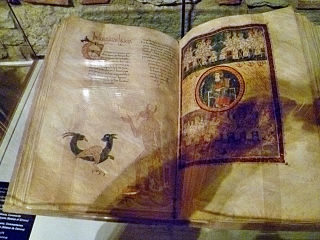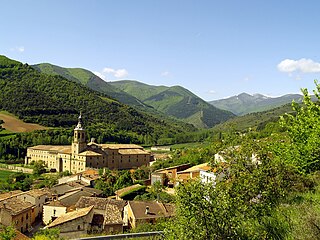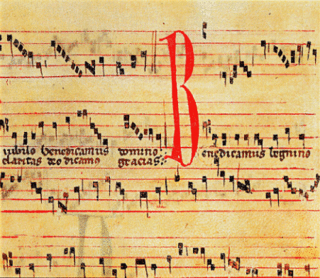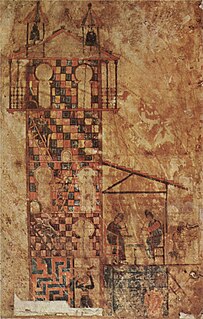 W
WThe cartularies of Valpuesta are two medieval Spanish cartularies which belonged to a monastery in the locality of Valpuesta in what is now the province of Burgos, Castile and León, Spain. The cartularies are called the Gótico and the Galicano from the type of script used in each. They are housed in the National Archives of Spain.
 W
WThe Escorial Beatus is a 10th-century illuminated manuscript of the Commentary on the Apocalypse by Beatus of Liébana. The illuminations of the manuscript show similarities in style to those produced by Florentius, the artist responsible for a copy of the Moralia in Job of Pope Gregory I. The manuscript was probably created at the monastery at San Millán de la Cogolla. There are 151 extant folios which measure 395mm by 225mm. The manuscript is illustrated with 52 surviving miniatures.
 W
WThe Gerona Beatus is a 10th-century illuminated manuscript currently housed in the museum of Girona Cathedral, Catalonia, Spain.
 W
WThe Glosas Emilianenses are glosses written in a Latin codex. These marginalia are important as early examples of writing in a form of Romance similar to Spanish, and in Basque. The anonymous author is assumed to have been a monk at the monastery now known as Suso, one of the twin monasteries of San Millán de la Cogolla. He wrote about a thousand years ago in three languages:A simplified version of Latin The medieval form of a Hispanic Romance language ; Medieval Basque
 W
WThe Codex Las Huelgas (E-BUlh) is a music manuscript or codex from c. 1300 which originated in and has remained in the Cistercian convent of Santa María la Real de Las Huelgas in Burgos, in northern Spain. The convent was a wealthy one which had connections with the royal family of Castile.
 W
WThe Morgan Beatus is an illuminated manuscript with miniatures by the artist Magius of the Commentary on the Book of the Apocalypse by the eighth-century Spanish monk Beatus, which described the end of days and the Last Judgment. Having been created at some time in the 10th century, the Morgan Beatus is one of the oldest examples of a revived Spanish apocalypse tradition. According to the style it was created by Mozarabs. The Apocalypse and the commentary on this scripture by Saint Beatus of Liébana became one of the most important religious texts of the Middle Ages, and was often illustrated very fully.
 W
WThe San Millán Beatus is an illuminated manuscript now held in the Real Academia de la Historia in Madrid as Cod. Emil. 33. It measures 35.5 cm by 23 cm and is a copy of the Commentary on the Apocalypse by Beatus of Liébana. Its illuminations are incomplete, but its text is one of the most complete surviving copies of the commentary. As well as Beatus' commentary, it contains saint Jerome's prologue on the Apocalypse and commentary on the Book of Daniel and extracts from Isidore of Seville's Etymologiae. It is made up of 282 bound folios - there are 48 miniatures on the first 228 pages and 1 miniature on the remaining 54 pages.
 W
WThe Tábara Beatus or Beatus of Tábara is a 10th-century illuminated manuscript, containing the Commentary on the Apocalypse by Beatus of Liébana. It originated in the San Salvador de Tábara Monastery and is now held in Spain's National Historical Archive in Madrid under the catalogue number L.1097B. Only eight of its original hundred miniatures survive.
 W
WThe Urgell Beatus, Beatus d'Urgell or Beatus la Seu d'Urgell is a 10th-century illuminated manuscript and medieval commentary. It is at Musei Diocesá de La Seu d'Urgell, at La Seu d'Urgell in Spain.
 W
WThe Beato of Valcavado is an illuminated manuscript—copies of the Commentary on the Apocalypse of Saint John of Beatus of Liébana—copied by a monk called Oveco in the year 970, in the now-vanished Our Lady of Valcavado monastery in Palencia. It is held in the collection of the Santa Cruz Palace.